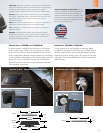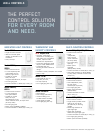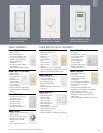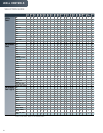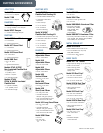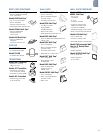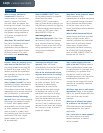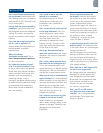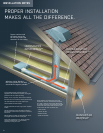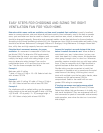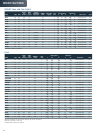
INSTALLATION
Can I mount Broan fans above my
tub and shower? Most Broan fans
are rated for use over a shower or
bathtub with a GFCI (Ground Fault
Circuit Interrupter).
Can my bath fan be surrounded by
insulation? Yes. Broan bath fans
are designed to provide adequate
cooling for motors and lighting,
as well as products with integral
heaters.
Can I vent more than one bath fan
out of a roof or wall cap? No.
Always follow the manufacturer’s
recommended ventilation
requirements.
What is the Broan
Ventilation fan warranty? Go to
http://www.broan.com/warranty
for this information.
Do I need attic access to install
a fan in a retrofit situation? Refer
to the product matrix for specific
Broan fans that may be installed
without access from above with
features such as telescoping
mounting frames, snap-in
housings, bendable mounting ears,
drywall-mounting tabs and inside-
out mounting duct connectors.
Room-side retrofit installations
are now a reality.
Can I install a heater over the
bathtub or in a shower?
No. Heaters are not UL Listed
(Underwriter’s Laboratory) for
installation over a bathtub or
in a shower.
Can I use an inline or multi-port fan
in one large bathroom? Yes, this
works the best for large rooms
because you can install the ports
over the areas where the
ventilation is needed the most
(source control). The size of the
multi-port would be determined
by the size of the room.
Can larger diameter ducting be
used with my bath fan? Yes, larger
diameters will result in improved
performance.
Can I use a smaller diameter duct
than what the fan is designed for?
This is not recommended. It will
cause the fan to run harder, greatly
reducing the CFM performance of
the fan and create excess noise.
What type of duct is recommended,
rigid or flexible? It is recommended,
where possible, to use rigid duct. It
has less resistance to air flow and
allows the fan to operate much
more efficiently. If flexible duct is
used, be sure the duct is as
straight as possible.
Can I exhaust my fan into my attic
instead of out the roof or wall?
Never exhaust air into spaces
within walls, ceilings, attics, crawl
spaces or garages. Humidity may
damage the structure and
insulation.
Where should the exhaust fan
be located? Exhaust fans should
be located in or near the shower
or tub, and in an enclosed water
closet. Keep exhaust points
opposite the supply air source to
ensure that the fresh air is drawn
through the room. Bathroom doors
should not be sealed too tightly at
the bottom in order to allow
“makeup air” to enter the room
when the door is closed.
In what direction should I orient the
exhaust outlet? The exhaust outlet
is the point where air is discharged
through the body of
the fan housing into the ductwork.
During installation, orient your fan
with the exhaust outlet pointing
toward the exit vent on your roof or
wall to minimize turns in ductwork
that impede airflow.
Will a bath fan or wall-mount utility
fan serve as a range hood?
No. Range hoods are specifically
designed to handle grease and
high temperature environments.
Broan bath fans supplement odor
and moisture removal in the
kitchen, but are not intended
for use as a range hood.
Can I use CFL or LED bulbs in
fan/lights with A19 screw-base
sockets? Yes, if key guidelines
are followed. Go to broan.com
FAQs for details.
57



